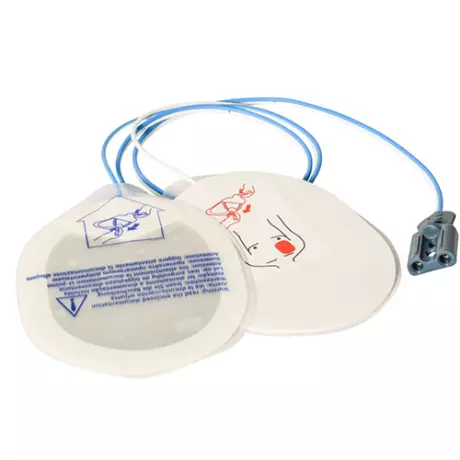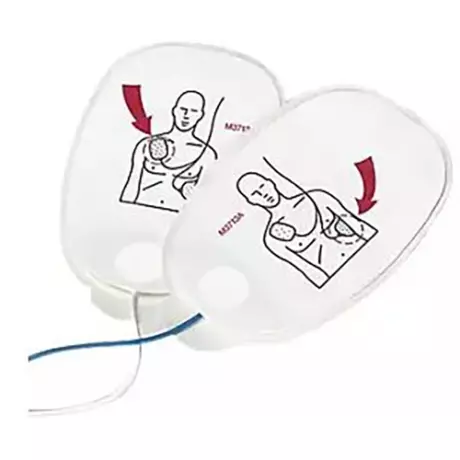
Defi electrodes for Philips (F7950)
Defi electrodes for Philips (F7950) Multifunction for adults Disposable, a 1 pair, PU= 1/10/100 Hear...
Portal and digital medical technology fair of the largest MedTech cluster in Germany

Defi electrodes for Philips (F7950)
Defi electrodes for Philips (F7950) Multifunction for adults Disposable, a 1 pair, PU= 1/10/100 Hear...

Defibrillation electrodes Original Philips...
Defibrillation electrodes Original Philips M3713A for adults, suitable for: Heartstart XL, XL+ Heart...
Ihre Suche lieferte keine Ergebnisse, aber Sie können sich auf dieser Seite präsentieren
Mit einem Eintrag auf Weltzentrum der Medizintechnik platzieren Sie Ihr Unternehmen bei Google & Co. ganz weit oben und erreichen so jeden Tag mehrere Tausend potentielle Kunden aus der Medizintechnikbranche. Mehr Informationen gibt es auf der Firma eintragen - Seite.

Resuscitation aids can be used in a variety of emergency situations. First, if the casualty is unresponsive, a cloth or towel should be placed over the casualty's mouth and nose. Then, begin CPR by performing compression only until an ambulance arrives. In some cases, the victim may respond to other forms of assistance, such as choking and gasping. For those cases, personal protective equipment, such as gloves, may also be helpful.
Second, resuscitation aids can provide a more complete resuscitation technique. There are many different types of resuscitation aids. There are many types of resuscitation sheets and masks available. Some are designed to reduce direct contact between the first aid provider and the patient and reduce the inhibition threshold. Some resuscitation blankets are tested by the Professional Association for Industrial Safety (PAIS). In addition to resuscitation blankets, hyperventilation masks should be available in large gatherings.
Resuscitation aids are also used to assist with breathing. There are many types available. One is a face shield with a one-way valve, which is useful for mouth-to-mouth resuscitation. This type of device is disposable and makes the use of it much more convenient. Both are useful items for first-aiders, and the latter should be carried at all times. They should be placed near the victim's head, if the patient can't breathe independently.
A mouth-to-mouth resuscitation device is a vital piece of medical equipment. These devices allow the first aid provider to inflate the patient's lungs. They are a great way to prevent a life-threatening situation, and these aids are often worn by first aiders. The most effective resuscitation aids are the ones that are designed to be portable. These are essential tools for emergency care providers.
In the case of a cardiac arrest, a person must be conscious and breathe normally. If a patient is not responding, he or she needs to be given CPR to keep the heart pumping. However, it's important to remember that this is not a resuscitation aid; it's a protective measure. If the patient can't breathe, it's necessary to start cardiopulmonary resuscitation.
The first step in resuscitation is to identify the cause of the cardiac arrest. Then, the individual should receive CPR, which can be life-saving. If the person is unconscious or unresponsive, the first aid should be administered in the first five minutes. Then, he or she can call 911 and inform the operators of the emergency. As soon as the person has regained consciousness, the operator will organise help.
In case of a cardiac arrest, the person must be placed on a stretcher. The victim must be kept as still as possible to ensure that he or she can breathe. Then, the person should be positioned properly in order to prevent the person from collapsing. If the patient is unconscious, the patient must be held upright and repositioned. Then, the patient must be prone to a fall or collapse.
The American Heart Association and the European Resuscitation Council have changed their policies on the use of CPR. Chest compressions may not be effective in starting a heart, but they can help maintain oxygenated blood flow to the brain and heart. As a result, they can extend the successful resuscitation window. Therefore, resuscitation aids are an essential part of emergency care. If the child's heart has stopped beating, CPR is crucial.
It is important to have a kit at the ready. An emergency medical kit should be prepared with a mask, a face shield, and a pair of gloves. The latter is the most effective when the patient is unconscious and the patient is not breathing. A resuscitation kit must contain all the resuscitation equipment and should not only be available in hospitals, but also at home. The resuscitation aids should be used in a hospital or in a health club.
Conventional CPR involves a chest compression and mouth-to-mouth breathing. This method involves giving the person a series of rescue breaths until he or she is breathing normally. If CPR fails to revive the person, the rescuer should continue performing chest compressions until the paramedics arrive. The patient's airway should be open at all times. If the patient isn't breathing, the first aid should immediately administer two rescue breaths.
Become a digital exhibitor yourself in the online portal of the largest and best-known MedTech cluster region in Germany and inform the world of medical technology about your products and services as well as about news, events and career opportunities.
With an attractive online profile, we will help you to present yourself professionally on our portal as well as on Google and on social media.